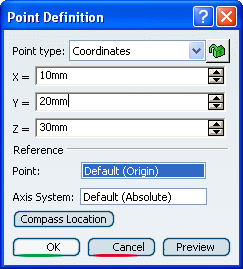
Update an Equation
In this example, you change 3 parameters, a, b and c before solving
the equation. If you use the Synchronous mode, an error is
displayed when modifying the parameters values because the update is
launched at each modification. To ensure the stability of the equation,
the update must be launched after the 3 parameters are changed. Thus
you need to select Update relation at global update
Create 4 real type parameters, a, b, c, and x. x
is a parameter valuated by an equation based on the other 3 parameters
(a, b, and c).
Valuate the parameters. a =1. b=2. c=1.
Create a set of equation and enter the following
equation: a*x**2+b*x+c==0. Click Parse
and use the left arrow to move the parameters to the Constant
parameters column. Click Solve when done.
Expand the Relations node (if need be), right-click
the Set of Equations and select Properties.
In the Properties window, select Synchronous.
Click OK to validate.
Double-click a in the specification
tree. The Edit Parameter window is displayed. Enter 2
in the value field. A message is displayed indicating that the equation
cannot be solved and click OK. Click Close. Right-click the Set of Equations and select
Properties. In the Properties window, unselect
Synchronous and select Update relation at global
update. Click OK to validate. Double-click a in the specification
tree. The Edit parameter window is displayed. Enter 3
in the value field. Click OK. Double-click b in the specification
tree. The Edit parameter window is displayed. Enter 5 in the value
field. Click OK. Double-click c in the specification
tree. The Edit parameter window is displayed. Enter 2
in the value field. Click OK. Right-click the equation in the specification tree
and select Local update. The equation is updated as well
as the x value. For the equation to be solved, the Update relation
at global update command option must be checked and the relation
must be either integrated to the global update or updated manually
using Local Update.
- For a given relation,
it is possible to determine that it only executes in
Synchronous mode using the Edit > Properties
command. Its evaluation can then be launched manually.
The Synchronous mode enables you to create
synchronous relations, that is to say relations that
will be immediately updated if one of their parameters
is modified. Relations based on parameters are the only
ones that can be synchronous.
- For a given relation, it is also possible to decide
that its evaluation will be launched when the part is
updated (Update relation at global update command).
The relations can be asynchronous for 2 reasons:
- You want the relation to be asynchronous
- The relation contains geometry.
- It is possible to change the update mode of a relation
after it is created. To do so, right-click the relation
in the specification tree and select Properties
and select Synchronous or Update
relation at global update check box.
|
![]()
